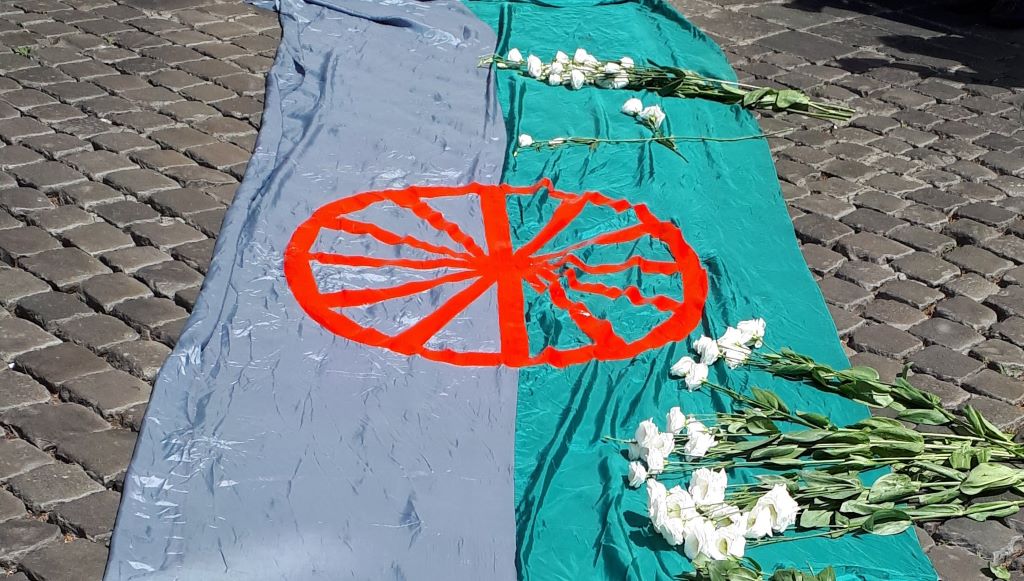The continued legacy of the Roma and Sinti genocide
18.3.2025
To prevent history from repeating itself, it is essential to address the deeply ingrained antigypsyism prevalent in many European societies. The RomniME project seeks to combat this discrimination, specifically focusing on the challenges faced by Roma women. By raising awareness of the compounded effects of multiple forms of discrimination, the project aims to foster a deeper understanding and ultimately build more inclusive and equitable societies.

On February 5th, 2025, an important meeting was held in Isernia, Italy, as part of the RomniMe project. The central theme of the event was Samurdaripen, the genocide suffered by the Roma and Sinti during World War II — a tragic chapter of history that deserves to be known and remembered. While the genocide of Jews is widely known and recognised, the atrocities committed against the Roma and Sinti have often been overlooked in mainstream historical narratives. Yet, the scale of the violence endured by these communities was equally devastating.
The keynote speaker of the day was Concetta Sarachella, a mentor and expert in minority rights, who guided participants through the history and memory of this often-forgotten genocide, which had a devastating impact on the Roma and Sinti communities.
The Nazi ideology and Roma persecution
The persecution of the Roma and Sinti people predates the Nazi regime, with centuries of discrimination and social marginalisation in Europe. However, with the rise of Adolf Hitler and the Nazi Party, this longstanding prejudice was elevated to a state-sponsored policy of persecution, in which the Roma and Sinti were targeted for their ethnicity.
The Nazis viewed the Roma as racially inferior, categorising them alongside Jews and other minority groups as enemies of the state. According to Nazi racial theories, the Roma were considered a threat to the purity of the “Aryan race.” By the mid-1930s, policies of sterilisation, forced labour, and incarceration were implemented against them, mirroring the Nazi approach toward Jews.
In 1935, the Nuremberg Laws were passed, explicitly defining Roma as racially inferior, thus laying the groundwork for their mass persecution. The Roma were subjected to forced relocations, forced sterilisation, and imprisonment in camps. By the time World War II began in 1939, the systematic genocide of the Roma had already started.
The term Samurdaripen in the Romani language means “genocide”. It has been used to describe the violence and systematic persecution these groups endured in Nazi concentration camps, where thousands of Roma and Sinti were deported and/or killed.
The scale of the Samurdaripen
The Samurdaripe was not limited to Germany but extended across Nazi-occupied Europe. Roma and Sinti families were rounded up, placed into concentration camps, and subjected to appalling conditions. Many Roma were murdered in gas chambers, while others died from forced labour, starvation, disease, or medical experiments.
The most infamous site of Roma extermination was Auschwitz-Birkenau, where a “Gypsy Camp” (Zigeunerlager) was established. Roma prisoners were treated as subhuman, subjected to forced labour, and executed in large numbers. Thousands were killed outright, while others suffered slow deaths from disease and malnutrition. Between 220,000 and 1.5 million Roma are estimated to have perished during the Holocaust, though exact figures remain unclear due to incomplete records and the often-nomadic lifestyle of the Roma.
Post-war neglect of Roma suffering
After World War II, the genocide of the Roma was largely ignored in official accounts of the Holocaust. While the plight of Jewish victims was widely recognised, the Roma were often excluded from Holocaust remembrance. In part, this can be attributed to the prevailing anti-Roma sentiment in Europe at the time, as well as the lack of organised advocacy within the Roma community.
It was not until the 1980s and 1990s that the genocide of the Roma began to receive more public recognition, thanks to efforts by Roma survivors and advocates.
Concetta Sarachella emphasised that despite efforts to keep the historical memory of these events alive, the genocide of the Roma and Sinti is still given little space in school curricula and is often forgotten by institutions and society.
The legacy of the Samurdaripen
While the Roma were devastated by the events of the Holocaust, their suffering did not end with the defeat of the Nazi regime. Instead, the legacy of the Samurdaripen is evident in the ongoing discrimination, marginalisation, and exclusion that Roma communities face to this day.
Across Europe, the Roma face systemic discrimination in areas such as housing, education, and employment. Discriminatory laws, hate speech, and social stigma continue to permeate Roma’s life, often condemning entire communities to lives of poverty and exclusion. Roma communities are frequent targets of violence and hate crimes, from physical assaults to verbal abuse.
During the meeting, discussions addressed the ongoing struggles of the Roma and Sinti communities in overcoming stereotypes and prejudices. The importance of initiatives that promote social inclusion and the recognition of their dignity was highlighted.
The event served as an opportunity to reflect on the need for cultural change to overcome antigypsyism, a deeply rooted challenge in society. Through dialogue and mutual understanding, bridges can be built to foster respect and comprehension among different cultures, ensuring that history does not repeat itself.
The RomniMe project reaffirmed its role as an essential platform for raising awareness, not only to remember the suffering of the past but also to contribute to the construction of a more inclusive and diversity-conscious society.
The article was written by the association Romni APS from Italy. Romni is one of the organisations implementing the RomniME project coordinated by the Deaconess Foundation. The project aims to develop a model based on community work and mentoring to improve the well-being and inclusion of young Roma women. The project, which is taking place in Finland, Bulgaria, Italy and Croatia, also aims to identify and combat discrimination experienced by Roma women and girls by improving understanding of the impact of multiple discrimination. The project is co-funded by the Citizens, Equality, Rights and Values Programme (CERV) of the European Union.